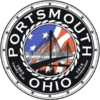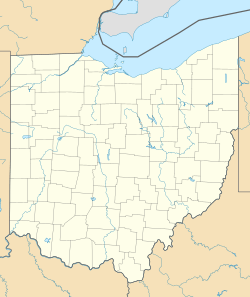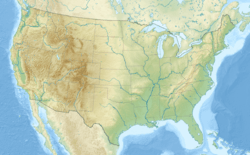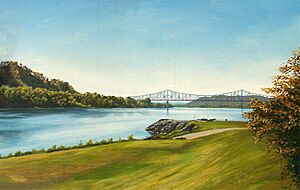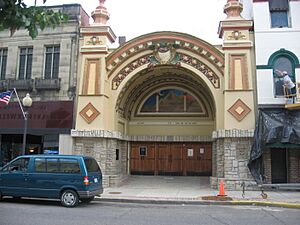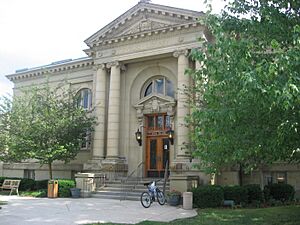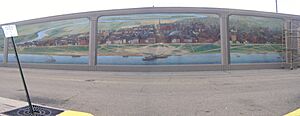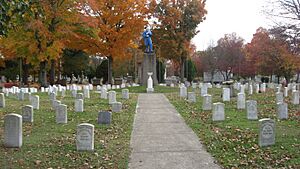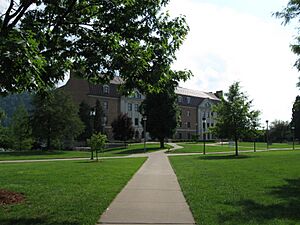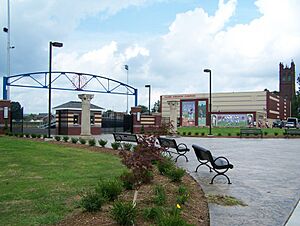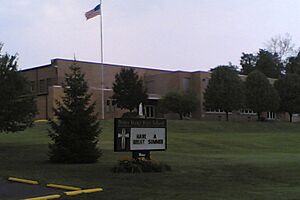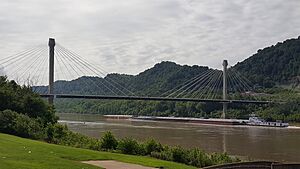Portsmouth, Ohio facts for kids
Quick facts for kids
Portsmouth, Ohio
|
|||
|---|---|---|---|
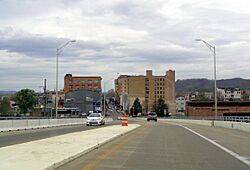
Downtown Portsmouth looking north from U.S. Grant Bridge
|
|||
|
|||
| Nickname(s):
P-Town
|
|||
| Motto(s):
"Where Southern Hospitality Begins"
|
|||
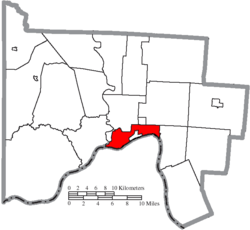
Location of Portsmouth in Scioto County
|
|||
| Country | United States | ||
| State | Ohio | ||
| County | Scioto | ||
| Founded | 1803 | ||
| Incorporated | 1815 | ||
| Government | |||
| • Type | Council–manager | ||
| Area | |||
| • Total | 11.08 sq mi (28.69 km2) | ||
| • Land | 10.73 sq mi (27.79 km2) | ||
| • Water | 0.35 sq mi (0.90 km2) | ||
| Elevation | 846 ft (258 m) | ||
| Population
(2020)
|
|||
| • Total | 18,252 | ||
| • Density | 1,701.18/sq mi (656.82/km2) | ||
| Time zone | UTC-5 (EST) | ||
| • Summer (DST) | UTC-4 (EDT) | ||
| ZIP code |
45662
|
||
| Area code(s) | 740 | ||
| FIPS code | 39-64304 | ||
| GNIS feature ID | 1086933 | ||
Portsmouth is a city in Ohio, United States. It is the main city of Scioto County. Portsmouth is located in southern Ohio, about 41 miles (66 km) south of Chillicothe. It sits on the north bank of the Ohio River, right across from Kentucky. The city is also just east of where the Scioto River flows into the Ohio River. In 2020, about 18,252 people lived there.
Contents
- History of Portsmouth
- Portsmouth's Geography
- Population of Portsmouth
- Portsmouth's Economy
- Arts and Culture in Portsmouth
- Parks and Recreation in Portsmouth
- Sports in Portsmouth
- Education in Portsmouth
- Media in Portsmouth
- Transportation in Portsmouth
- Notable People from Portsmouth
- Sister Cities
- Images for kids
- See also
History of Portsmouth
How Portsmouth Began
A long time ago, in 1758, a Shawnee village was built where Portsmouth is now. This happened after a flood destroyed their old village.
Later, in the 1790s, European-Americans started a small town called Alexandria nearby. But Alexandria often flooded because it was too close to the Ohio and Scioto rivers. There was a very big flood in 1937.
In 1803, a man named Henry Massie found a better, higher place for the town. He planned out the new city, mapping its streets and dividing the land. Portsmouth was officially founded in 1803 and became a city in 1815. Alexandria soon disappeared.
Portsmouth's Growth and Industry
Portsmouth grew quickly because it was located where the Ohio and Scioto rivers meet. This was a great spot for industry and shipping. Early businesses included meat packing and shipping for farms further north.
The city grew even more when the Ohio and Erie Canal was finished. This canal connected Portsmouth to the Great Lakes, opening up new markets in the north. Later, the building of the N&W and B&O train yards also helped the city grow. Trains soon carried more goods than the canal. By the late 1800s, Portsmouth was one of the most important cities on the Ohio River.
By 1916, Portsmouth was a major industrial center. It was the fourth-largest shoe manufacturing city in the country. It also made the most fire and paving bricks in the United States. A steel company, Wheeling-Pittsburgh Steel, employed over a thousand people. There were also 100 other factories making everything from furniture to engines.
The neighborhood called Boneyfiddle grew rich from all this industry and shipping. Many grand buildings were built there. Over time, businesses moved to Chillicothe Street, which is still the main street today. Boneyfiddle is now being rebuilt, but it's not as busy as it once was. Portsmouth was also an important stop on the Underground Railroad in the 1800s. Enslaved people seeking freedom used this route to travel north to Canada.
Changes in Portsmouth
Portsmouth's population was highest in 1930, with over 42,000 people. But by the 1950s, the population started to drop. Many industrial jobs moved away from the area. This was due to competition from other countries and changes in how industries worked.
For example, in 1980, the Empire-Detroit Steel plant closed. This meant 1,300 steelworkers lost their jobs. The plant needed new equipment that the new owners did not want to install. By 2010, the city's population was about 20,000. Like many cities, Portsmouth has seen jobs move away and people move to bigger cities.
Portsmouth's Geography
Portsmouth is located where three rivers meet: the Ohio River, the Scioto River, and the Little Scioto River. It's about halfway between four big cities: Charleston, West Virginia, Cincinnati, Columbus, Ohio, and Lexington, Kentucky. Each of these cities is about a two-hour drive away.
The land around Portsmouth is very hilly. This is because it's part of a "dissected plateau," which means rivers have carved deep valleys into the flat land. Portsmouth itself sits next to the Scioto and Ohio rivers. The city covers about 11.07 square miles (28.69 square kilometers). Most of this is land, with a small amount of water.
Neighborhoods in Portsmouth
- Sciotoville is about 5 miles (8 km) east of Portsmouth. It's part of the city, connected by a narrow strip of land.
- Boneyfiddle is a historic area west of downtown Portsmouth.
- Alexandria is located where the Scioto and Ohio rivers meet. This was the site of the original town.
- Rosemount is about 5 miles (8 km) north of Portsmouth. It's outside the city limits but is a big residential area for people in Portsmouth.
- Hilltop includes residential areas in the northern part of Portsmouth.
Population of Portsmouth
| Historical population | |||
|---|---|---|---|
| Census | Pop. | %± | |
| 1820 | 527 | — | |
| 1830 | 1,378 | 161.5% | |
| 1840 | 1,544 | 12.0% | |
| 1850 | 4,011 | 159.8% | |
| 1860 | 6,268 | 56.3% | |
| 1870 | 10,592 | 69.0% | |
| 1880 | 11,321 | 6.9% | |
| 1890 | 12,394 | 9.5% | |
| 1900 | 17,870 | 44.2% | |
| 1910 | 23,481 | 31.4% | |
| 1920 | 33,011 | 40.6% | |
| 1930 | 42,560 | 28.9% | |
| 1940 | 40,466 | −4.9% | |
| 1950 | 36,798 | −9.1% | |
| 1960 | 33,637 | −8.6% | |
| 1970 | 27,633 | −17.8% | |
| 1980 | 25,993 | −5.9% | |
| 1990 | 22,676 | −12.8% | |
| 2000 | 20,909 | −7.8% | |
| 2010 | 20,226 | −3.3% | |
| 2020 | 18,252 | −9.8% | |
| 2021 (est.) | 18,014 | −10.9% | |
| Sources: | |||
Portsmouth in 2010
In 2010, there were 20,226 people living in Portsmouth. Most residents (90.1%) were White. About 5.1% were African American, and smaller percentages were Native American, Asian, or from other backgrounds. About 2.2% of the population was Hispanic or Latino.
The average age in the city was 36.1 years old. About 21.6% of residents were under 18.
Portsmouth's Economy
Some of the biggest employers in Portsmouth are the Southern Ohio Medical Center and Kings Daughters Medical Center Ohio. Shawnee State University also provides many jobs. Other important employers include Norfolk Southern Corp. (a railroad company) and OSCO Industries.
The Portsmouth Gaseous Diffusion Plant in nearby Piketon, Ohio, is a historic site. From 1952 to the mid-1960s, it enriched uranium for nuclear weapons. Later, it produced fuel for commercial nuclear power plants. The plant stopped enriching uranium in 2001. Now, the site is being cleaned up for future use.
Graf Brothers Flooring and Lumber, a large wood flooring company, has two log yards in Portsmouth. Portsmouth is also home to Sole Choice Inc., one of the world's biggest makers of shoelaces.
Arts and Culture in Portsmouth
Buildings and Historic Places
Many old buildings in Portsmouth have been torn down. This happened because they were not taken care of, or new buildings replaced them. Some old landmarks that are gone include the old train station and some early 20th-century churches.
However, many buildings from the early 1800s still stand. Old churches remind people of Portsmouth's past. The historic Columbia Theater burned down in 2007. But its front was saved and used in the new open-air Columbia Music Hall, built in 2012. Other important historic buildings include an old monastery and Spartan Stadium. Many buildings in the Boneyfiddle Historic District are also listed on the National Register of Historic Places.
In 2016, a professor from Shawnee State University worked to save Spartan Municipal Stadium. This stadium opened in 1930. It was the first home of the Portsmouth Spartans, which later became the Detroit Lions in the National Football League. In November 2016, the city won a $25,000 grant to help fix up the stadium.
Portsmouth Public Library
The Portsmouth Public Library was founded in 1879. It is the city's main library and has branches throughout Scioto County. The Southern Ohio Museum, started in 1979, has over 60 exhibits. These include art, China dolls, Native American artifacts, and works by local artists.
Portsmouth's Floodwalls and Murals
Even though Portsmouth was built on higher ground, it used to flood often. There were big floods in 1884, 1913, and 1937. After the huge flood of 1937, the U.S. Army Corps of Engineers built a large floodwall to protect the city. This wall has stopped two major floods since then.
In 1992, Portsmouth started honoring local heroes by putting a star on the floodwall. This is called the Portsmouth Wall of Fame.
Also in 1992, a group decided to create a tourist attraction on the floodwall. They hired artist Robert Dafford to paint murals about Portsmouth's history. He worked with local art student Herb Roe. The project grew to include sixty murals, each 20 feet (6 meters) tall. They stretch for over 2,000 feet (610 meters).
The murals show many parts of the area's history. They include:
- The Portsmouth Earthworks, ancient mounds built by the Hopewell culture.
- Lower Shawneetown, a Shawnee village from the 1700s.
- Tecumseh, a famous Shawnee leader.
- Henry Massie, who helped found Portsmouth.
- A Civil War unit from Portsmouth.
- Jim Thorpe, a Native American athlete who played football in Portsmouth.
- The Portsmouth Spartans, the city's NFL team that later became the Detroit Lions.
- Branch Rickey, a baseball executive who signed Jackie Robinson.
- Local artists, photographers, and the big Ohio River flood of 1937.
- Different types of transportation, like riverboats and trains.
- Famous people from the area, like Roy Rogers and Jesse Stuart.
- Other murals show local industries, schools, and a memorial for veterans.
The main mural project finished in 2003. More murals have been added since then. These include murals honoring baseball heroes and a bicycle tour event.
Indian Head Rock
The Indian Head Rock is a huge, eight-ton rock that used to sit at the bottom of the Ohio River. People carved figures and names into the rock when the river levels were low. In 1917, a dam was built downstream, which meant the rock would be underwater forever. But a group of local divers found and recovered it. This led to a legal fight between Kentucky and Ohio over who owned the rock. In 2010, the rock was returned to Kentucky.
Guinness World Records in Portsmouth
Portsmouth citizens have worked together to set several Guinness World Records. In 2018, the "Friends Plant Portsmouth" group broke the record for the most people potting plants at the same time. Later that year, Portsmouth also broke the record for the most people singing Christmas carols together, with 1,822 carolers. They also set a new record for the most people wrapping Christmas presents at the same time.
Parks and Recreation in Portsmouth
Portsmouth has 14 parks for everyone to enjoy. These include Alexandria Park, Bannon Park, Branch Rickey Park, Buckeye Park, and many others.
The Spock Community Dog Park opened in 2019. It is named after a police dog who died protecting his partner. This park gives people a place to walk and play with their dogs. A new skate park is also planned for the future.
Swimming Pools
The McKinley Swimming Pool was built on Findley Street. It was named in memory of Eugene McKinley, a 14-year-old who drowned. Another pool, called Dreamland Pool, was owned by the Terrace Club. In the 1960s, during the Civil Rights Movement, there were protests because the Dreamland Pool was still segregated. This meant African Americans were not allowed to swim there.
On July 17, 1964, a "wade-in" protest happened at Dreamland Pool. The next summer, in 1965, the pool's owners decided to allow African Americans to swim there. The McKinley Pool opened in 1966. It stands as a symbol of Portsmouth's efforts to become more fair and equal for everyone.
Greenlawn Cemetery
Greenlawn Cemetery was started in 1829. It is 40 acres in size and is Portsmouth's only public cemetery. It includes several smaller cemeteries within it. The city takes care of the cemetery.
Sports in Portsmouth
Portsmouth had several semi-professional football teams in the 1920s and 1930s. One famous player was Jim Thorpe, who played for the Portsmouth Shoe-Steels.
From 1929 to 1933, Portsmouth was home to the Portsmouth Spartans. This team joined the National Football League (NFL) in 1930. They even played in the first professional football night game in 1930. Even though they were a good team, the Great Depression made it hard for them financially. So, the team was sold and moved to Detroit in 1934, becoming the Detroit Lions.
In the late 1990s, the Portsmouth Explorers were a minor league baseball team. Portsmouth was also home to the Portsmouth Red Birds, a minor league team for the St. Louis Cardinals in 1938.
More recently, Portsmouth has been home to Revolutionary Championship Wrestling. This wrestling show has featured famous wrestlers like Big Van Vader and Jerry "The King" Lawler.
Education in Portsmouth
Colleges and Universities
Shawnee State University is a public university in Portsmouth. It is the southernmost university in the University System of Ohio. Ohio University first opened a center in Portsmouth in 1945. Then, in 1986, Shawnee State University was officially created.
Shawnee State University offers many different degrees. These include nursing, business, sociology, biology, and psychology. They also offer master's degrees and a doctorate. The university has exchange programs with schools in Spain, Morocco, China, and Germany. About 3,000 undergraduate students attend SSU, along with hundreds of graduate students.
The university's campus is 62 acres and has 28 buildings. These include the Vern Riffe Center for the Arts and the Clyde W. Clark Planetarium. The university's library is called the Clark Memorial Library. The planetarium has a special system that shows views from the Hubble Space Telescope.
The Shawnee State "Bears" are the university's sports teams. They compete in the National Association of Intercollegiate Athletics (NAIA). In 2021, the men's basketball team won the NAIA national championship.
Schools for Kids
Portsmouth has one public school system and two private school systems. The Portsmouth City School District is the public school system. It has been serving the city since the 1830s.
Portsmouth City School District has a strong basketball history. The Trojan basketball team has won four state championships in Ohio. They have also made it to the state final four 14 times. The Trojan football team has also had successful seasons, winning a state championship in 2000.
In 2000, voters approved money to build new schools for the district. These new schools opened in 2006–07. They won an award for their excellent design. The school system also built a new $10 million athletic complex. This complex has a new football field, baseball field, softball field, tennis courts, and a track. It is named the Clark Athletic Complex. It features three murals by artist Herb Roe, who is a Portsmouth High School graduate. The murals show baseball, tennis, and football.
Notre Dame High School is a private school that has served the city's Catholic community since 1852. Its football team is also well-known, winning two state championships in 1967 and 1970.
Media in Portsmouth
Portsmouth is served by several television stations from nearby cities like Columbus and Cincinnati. There are also two local TV stations: WTZP-LD and WQCW. Local radio stations include WIOI, WKSG, and WNXT.
Portsmouth has three newspapers. The Portsmouth Daily Times is the city's only daily newspaper. The Community Common is a free newspaper published twice a month. The Scioto Voice is a weekly newspaper. Shawnee State University also has a student newspaper called the University Chronicle.
Transportation in Portsmouth
Roads
Two major U.S. Routes, 23 and 52, serve Portsmouth. Other important roads include several Ohio State Routes. The closest Interstate highway is I-64. There are plans for Interstate 73 and Interstate 74 to pass through Portsmouth in the future.
Trains
Portsmouth is an important place for the Norfolk Southern Railway. This company has a train yard and a repair facility here. Amtrak offers passenger train service to the Portsmouth area on its Cardinal route. The passenger station is in South Shore, Kentucky, just across the Ohio River from Portsmouth.
Air Travel
Portsmouth is served by the Greater Portsmouth Regional Airport (PMH). This is a general aviation airport for smaller planes. It is located about 12 miles (19 km) northeast of the city. The closest commercial airport for larger planes is Tri-State Airport (HTS) in Ceredo, West Virginia, about 53 miles (85 km) southeast of Portsmouth.
Public Transportation
Public transportation in Portsmouth and the surrounding areas is provided by Access Scioto County (ASC).
Notable People from Portsmouth
- James Mitchell Ashley – helped write the Thirteenth Amendment to the United States Constitution
- Henry T. Bannon – U.S. representative and author
- Kathleen Battle – opera singer
- Earl Thomas Conley – country music singer
- Bil Dwyer – cartoonist
- Chuck Ealey – former football player
- Steve Free – Appalachian musician
- Bill Harsha – Ohio politician
- Larry Hisle – former Major League Baseball player
- Liza Johnson – film director
- Rocky Nelson – former Major League Baseball player
- Al Oliver – former Major League Baseball player
- Wally Phillips – Chicago radio personality
- Branch Rickey – baseball executive who signed Jackie Robinson
- Barbara Robinson – author
- Herb Roe – mural artist
- Roy Rogers – singer and cowboy movie star
- Stuff Smith – jazz musician
- Ted Strickland – former Ohio governor
- Gene Tenace – former Major League Baseball player
Sister Cities
Portsmouth has sister city relationships with:
Images for kids
See also
 In Spanish: Portsmouth (Ohio) para niños
In Spanish: Portsmouth (Ohio) para niños



